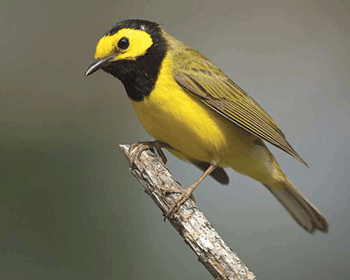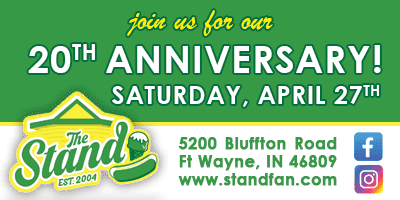MAY IS WARBLER TIME
 May is the month to look for warblers in Indiana and in the other mid-latitude states of the U.S. May is the month when the warblers that nest in those states return after spending the winter farther south, many in South America, and May is the month when warblers that nest farther north pass through Indiana.
May is the month to look for warblers in Indiana and in the other mid-latitude states of the U.S. May is the month when the warblers that nest in those states return after spending the winter farther south, many in South America, and May is the month when warblers that nest farther north pass through Indiana.
Warblers are little birds, most the size of the smallest sparrow, the chipping sparrow. They are active little birds when feeding, flitting about like bees in a bed of flowers in bloom. They migrate at night when the weather is fair, then feed in the morning after a night of travel.
Many warblers are colorful little birds and the names of many indicate their colors. There’s the yellow warbler, bright as a goldfinch, one of the earliest warblers to migrate north in spring and an Indiana nester. There’s the prothonotory warbler, also bright yellow and another Indiana nester though Indiana is the northern limit of its nesting range. It’s named for a church official who wears a bright yellow gown on official occasions.
There’s the common yellowthroat, a bird with a black mask above its bill and covering its eyes. There’s the yellow-rumped warbler which has yellow shoulder patches and crown as well as a yellow rump. The magnolia warbler, too, has a yellow rump and a yellow throat, breast and belly, the breast and belly streaked with black. The Kirtland’s warbler is yellow on its throat, breast and belly with black streaks on its sides. The Canada warbler has a yellow throat, breast and belly with a necklace of short black streaks. The Cape May warbler is nearly yellow overall with a chestnut patch on each cheek and two white bars on each wing.
Many warblers have yellow in their plumage but there are warblers with other colors too, as their names indicate. The male Blackburnian warbler has a bright orange throat, an orange line over each eye, an orange patch behind each eye and an orange topknot. Yellow replaces the orange in the female.
A male American redstart is black with red patches on its shoulders, in its wings and its tail. A female redstart is greenish-yellow with yellow patches where the male has red. There’s a chestnut-sided warbler, a bay-breasted, black-throated green and black-throated blue warblers and cerulean which is blue with a white throat, breast and bellow and black streaks. There’s a black-and-white and a blackpoll warbler. Though black and white, somehow, to me at least, they seem brightly colored.
There are more, northern parula, pine, prairie, palm, worm-eating, Tennessee, orange-crowned. Butterflies of the bird world warblers have been called. On a day when there’s a fallout, a day when a large number of warblers has arrived and dropped into a woodlot during the night, trees and bushes seem to be alive with these little feathered sprites. I’ve spotted and identified thirty species, and more, on such a morning.
Colorful as they are, as the names of many indicate, active as they are when feeding, it would seem that warblers would be easy to spot. We birders know better. Warblers are insect eaters. Darting about, picking insects off buds and leaves and bark, even launching into the air like a flycatcher, they are about as difficult to see and focus binoculars on as the insects they pursue. After a morning in the woods with warblers overhead I have often gotten a sore neck after a couple hours of bending my head back and staring up, a warbler-neck we birders call it.
The ovenbird, a warbler of a different color, is a little brown bird that feeds and nests on the ground. That doesn’t make it any easier to focus on than warblers in the trees but it is easier on a birder’s neck.
- Birds As Weather Forecasters – Life In The Outdoors - December 17, 2021
- Rare Bird Spotted In Indiana – Life In The Outdoors - October 8, 2021
- MY EXPERIENCE WITH DEER – Life In The Outdoors - July 30, 2021


